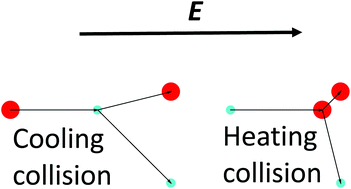Correcting the fundamental ion mobility equation for field effects†
Abstract
The fundamental ion mobility equation computes the energy-averaged collision cross section as a function of measured drift velocity, electric field strength, ion and neutral masses, and drift gas state parameters. As field strength approaches zero, in particular when the drift velocity drops below about 4% of the average ion-neutral thermal speed, the fundamental equation takes on an especially simple form because the collision frequency and average momentum transfer become indistinguishable from their thermal values. However, in modern high-performance IMS-MS instruments, ion drift velocities may be 10–50% or more of thermal speed, and analysis using the zero-field equation gives rise to erroneously large cross sections. We address this problem by developing correction factors for the zero-field equation from an improved momentum-transfer (MT) theory for ion mobility, corrected and completed herein, and from the well-known two-temperature (2T) theory. The corrected and uncorrected equations are compared by their ability to recover known hard-sphere cross sections from accurately-computed mobility data. Both MT and 2T expressions adjust for the field-driven increase in collision frequency and are noticeably superior to zero-field expression whenever the ion drift velocity is greater than ∼4% of thermal speed. The MT expression also adjusts for the mass and field dependent change in average momentum transfer, and is more accurate than the 2T first approximation whenever the mass of the ionic species is greater than about four times that of drift gas molecules, as is the case in most analytical applications of IMS coupled to MS.


 Please wait while we load your content...
Please wait while we load your content...